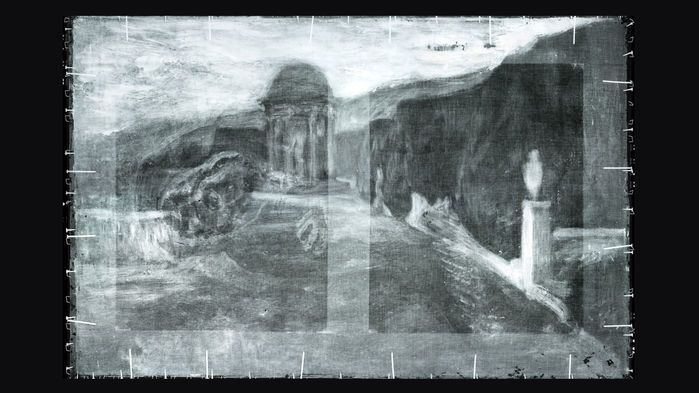Scientists Used A.I. to Recreate a Landscape Hidden Beneath a Picasso Painting
Physical reconstructions of the early 20th-century depiction of Barcelona are now on sale for $11,111.11 each
:focal(800x464:801x465)/https://tf-cmsv2-smithsonianmag-media.s3.amazonaws.com/filer/ab/44/ab44d72e-1fa9-4d43-b486-2fd69816e16c/final_parc_de_labyrinth_de_horta_cropped_11_dec_2020.jpeg)
During his Blue Period (1901–1904), a depressed and often cash-strapped young Pablo Picasso cut down on expenses by painting new works over old ones—both his own and otherwise.
A century later, advancements in X-ray photography have enabled researchers to rediscover a number of paintings hidden in these recycled canvases.
In 1992, for instance, conservators studying La Miséreuse accroupie, or The Crouching Beggar (1902), found a landscape lurking beneath Picasso’s portrait. The Art Gallery of Ontario (AGO) released a high-definition X-ray image of that forgotten work in 2018. The painted-over scene may be a depiction of Barcelona’s Parque del Labertino de Horta by Picasso contemporary Santiago Rusiñol.
Rusiñol’s original landscape remains obscured by Picasso’s composition. But as Sarah Cascone reports for Artnet News, a new project from physicist George Cann and neuroscientist Anthony Bourached seeks to recreate the lost work with the help of artificial intelligence and 3-D printing.
Dubbed Oxia Palus, the initiative stems from the pair’s PhD research at University College London. Bourached and Cann developed an algorithm that analyzes X-rays of painted-over works and generates plausible color images based on those scans, as well as comparable works from the same time period.
The scientists first published their techniques and creations in a 2019 paper aptly titled “Raiders of the Lost Art.” So far, they’ve used their method to create color images of 20 works previously only seen in X-rays. Per MIT Technology Review, a ghostly likeness of a woman hidden beneath Picasso’s famed The Old Guitarist was the first of these resurrected paintings.
Now, Bourached and Cann are taking their work one step further: Using a 3-D printer, they “painted” 100 canvases depicting Rusiñol’s landscape, as seen in the A.I.-generated image. The physical works boast realistic brushstroke textures, and each one has been inscribed with a code linking it to a non-fungible token (NFT), or digital file certifying its authenticity.
The replica canvases are available for purchase from MORF Gallery for $11,111.11 each. Oxia Palus dubs the works “NeoMasters” and notes that the technique used in their creation is patent pending, reports Deutsche Welle.
“In resurrecting this work beneath The Crouching Beggar, many paintings were referenced that define the style of Rusiñol’s work,” the scientists explain on the gallery’s website. “The depth, thickness, and approximate length of each and every brushstroke have been re-integrated into an embodiment of what was lost to the ages.”
Rusiñol (1861–1931) was a Spanish poet, playwright and painter who led the Catalan modernisme movement at the turn of the century, according to the Museo del Prado. Researchers suspect that Picasso used the mountains in Rusiñol’s landscape to shape the contours of his female subject’s back—“[k]ind of a jazz riff back and forth,” as scholar Marc Walton, who worked on the AGO’s X-ray analysis, told Kenneth Chang of the New York Times in 2018.
Given their backgrounds, Oxia Palus’ founders may seem like unlikely art connoisseurs: Bourached studies high-dimensional neuroscience, while Cann aids efforts to detect life on Mars.
As Cann tells Artnet News, the name Oxia Palus actually refers to “a region of Mars that has a lot of interest in the search for life, in particular in the subsurface.”
He adds, “In an analogous sense, with the exploration of this world and the search for life below it, we’re doing a very similar thing, but under the surface of the paint.”
Editor's Note, April 15, 2021: This article has been updated to more accurately reflect the scope of the Art Gallery of Ontario's 2018 research.
/https://tf-cmsv2-smithsonianmag-media.s3.amazonaws.com/accounts/headshot/nora.png)



/https://tf-cmsv2-smithsonianmag-media.s3.amazonaws.com/accounts/headshot/nora.png)